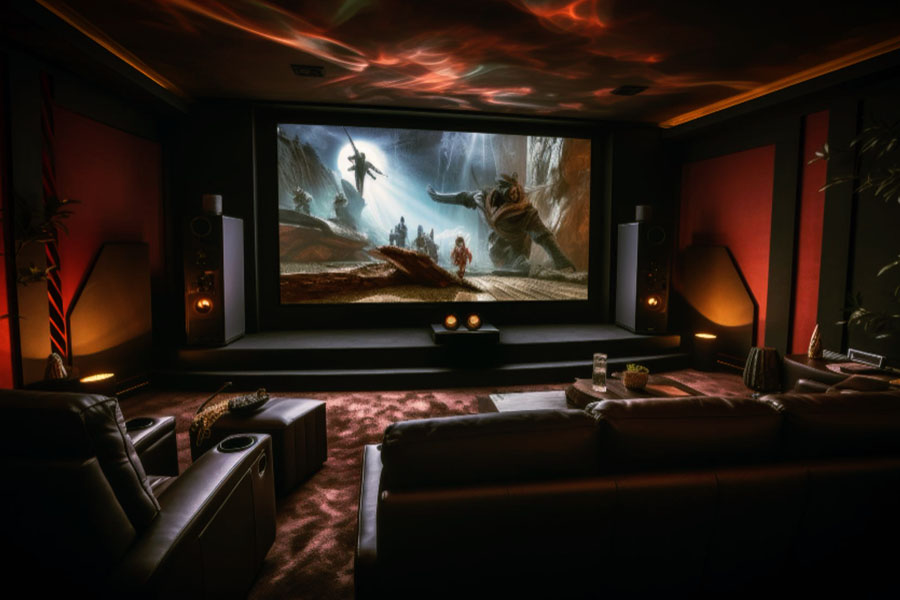Creating a home theater room involves more than just setting up a screen and chairs; it’s about crafting an immersive cinematic experience in your own space. Each element transforms a regular room into a dedicated entertainment hub. So, it is brilliant to know how to make a home theater room.
In this comprehensive journey, we’ll explore the essential elements that transform an ordinary room into an extraordinary entertainment hub. Every detail will be meticulously addressed, from optimizing acoustics and ambient lighting to curating the perfect video and sound system.
Say goodbye to compromises and hello to a true sensory overload. Get ready to dive into the finer points of speaker positioning, acoustic treatment, video calibration, and more!
How to Make a Home Theater Room
Planning considerations
Proper planning is essential for creating an optimal home theater experience within your desired budget. First, define your goals – do you want a dedicated theater or multi-use media room? Next, consider the room size and layout. Rectangular rooms with the right dimensions provide the best acoustics.
Measure the space and plan the seating position accordingly. Don’t forget lighting – you’ll need to control light leaks and have dimmable lighting. Finally, determine a realistic overall budget upfront, including equipment, seating, acoustic treatments, construction costs, and funds for future upgrades.

Budget and future-proofing
Setting a proper budget is essential. You need to account for all equipment, materials, and labor costs. But leave some room in your budget for future technology upgrades. Audio and video equipment evolve rapidly, so having an upgrade fund will help keep your home theater up-to-date.
Once your goals are defined, room dimensions sorted, lighting planned, and budget set, you’ll be on your way to creating an amazing space. This space will be perfect for theater-quality viewing of movies, shows, sports, and more.
So, proper planning ensures a fantastic home theater tailored to your needs. Don’t skip this crucial step to achieve home theater bliss.
Creating Your Ultimate Home Theater Room
Selecting the right location
The best location for a home theater room is a basement or ground floor, away from high-traffic areas that might cause noise disturbances. A rectangular room is ideal due to its excellent acoustics, allowing for even sound distribution without echoes.
To soundproof the space, add proper insulation to the walls, ceilings, floors, and any shared walls. Use blackout curtains or tinted windows to eliminate light leaks, creating a true cinema-like ambiance.
Also, carefully measure the room’s length, width, and ceiling height. This ensures the proper positioning of the speakers, screen, and seating while maintaining ideal sightlines. Choosing an isolated, insulated, light-controlled rectangular room with the right dimensions provides the perfect setup for an immersive home theater experience.
Choosing audio and video equipment
A surround sound speaker system and an audio/video receiver are essential for authentic home theater audio. Systems like 5.1, 7.1, or Dolby Atmos surround you with immersive soun. The receiver powers the speakers and processes the audio formats.
For video, you should choose a 4K Ultra HD projector or TV and pair it with a 4K Blu-ray player. Projectors offer a fantastic large-screen experience, while TVs are ideal for smaller rooms. And Blu-ray delivers the highest picture quality compared to streaming.
To future-proof your setup, select a receiver and player with the latest audio/video specifications and a smart platform for streaming. This ensures your system stays up-to-date as technology evolves.
Considerations for selection
When selecting gear, it’s important to consider the size and layout of the room. Larger rooms typically benefit from projectors, while smaller ones are better suited for TVs. The room’s dimensions will help determine the ideal screen size, while the layout will guide the positioning of the speakers.
Furthermore, it’s essential to set a realistic budget, considering the cost of equipment and any professional installation needed. Remember that higher-end gear performs better but has a higher price tag.
Also, consider plans for future upgrades and carefully measure the viewing distances and speaker locations. And don’t overlook the importance of audio calibration to fine-tune the sound to your preferences.
Creating a comfortable environment
When designing your home theater room, creating a comfortable environment is crucial. So, you need to consider the following components about how to design a home theater room:
Ambient lighting setup
You should install dimmable lights and bias lighting behind the screen to create the ideal ambiance in your home theater. Place these lights away from the screen to prevent hot spots or dark areas. With smart lighting systems, you’ll have convenient control over brightness levels and different lighting scenes.
Ambient lighting plays a vital role in setting the right mood and reducing eye strain during viewing sessions. By ensuring the lights are positioned correctly without affecting the on-screen image, you’ll achieve uniform illumination.
Comfortable seating arrangement
You should measure the room and plan seating for optimal viewing distances with unobstructed sightlines. Choose ergonomic seating options with good back support, such as recliners or rockers.
But allow enough space between rows for comfortable movement. You can consider adding footrests or cup holders for extra convenience.
Comfortable seating is crucial for an immersive and enjoyable home theater experience. Ergonomic design helps prevent fatigue during extended viewing sessions. Plus, adequate spacing between rows ensures easy access and movement.
Noise reduction and wall color
You will need to implement soundproofing measures such as insulation, mass-loaded vinyl, and acoustic panels to minimize external noise. One way is to enhance sound isolation by sealing gaps around doors and windows.
Also, opt for flat or matte neutral-colored paints to reduce reflections and create the desired ambiance. This noise reduction not only enhances audio clarity but also improves dialogue intelligibility.
Moreover, the right wall color can significantly impact the perceived brightness and overall feel of the space. Choosing flat or matte finishes helps eliminate distracting light reflections on the walls, creating a more comfortable environment.

Setting up Audio and Video Systems
Speaker setup
- Position front speakers at ear level, angled towards the listening area.
- Place the center speaker above or below the screen.
- Mount surround speakers on side/rear walls at ear height, aimed slightly towards the seating position.
Helpful tips
- Use stands or wall mounts for proper speaker positioning.
- Correct speaker placement ensures an enveloping sound field and clear audio imaging.
- Measure distances carefully for ideal speaker positioning.
- Follow the speaker manufacturer’s placement guidelines.
- Experiment with speaker positioning for best sound quality.
- Use acoustic treatments to manage room reflections.
Video display and connections
Projector installation
- Calculate the optimal throw distance for your room size.
- Mount the projector level and align it with the screen using a ceiling or wall bracket.
TV mounting
- Install the TV at an ideal viewing height for comfortable viewing.
- Conceal cables through in-wall conduits for a clean look.
Connecting sources
- Use high-quality HDMI cables to connect video sources (Blu-ray player or game console) to the display.
- Connect audio sources (TV or streaming devices) to the AV receiver.
- Organize and secure cables using cable ties or raceways for a tidy setup.
Tips for optimizing the viewing experience
- Choose a display with the appropriate resolution and aspect ratio for your desired viewing quality.
- For projectors, use a dedicated projector screen or control room lighting for optimal image quality.
- Calibrate display settings (brightness, contrast, color) for accurate and vibrant visuals.
- Ensure proper ventilation around video components to prevent overheating.
Testing and Enjoying the Home Theater Room
Testing the systems
Start by thoroughly testing the audio and video systems. Play content from various sources such as discs, streams, and devices to ensure everything functions correctly. Adjust audio levels to achieve balanced sound, clear dialogue, and consistent quality throughout the room.
Next, check inputs such as Blu-ray and streaming services for the video system. Calibrate settings to achieve a natural picture with smooth motion and proper geometry from every viewing angle. Be vigilant for any audio buzzing or video flickering issues. Move your seating position around to inspect all angles of the screen.
Additionally, test night and day video modes to ensure accurate color representation under different lighting conditions. Verify that the audio remains distortion-free even at higher volumes. Let thorough technical tests validate the overall performance of your home theater system.
Creating the environment
When the technical details are sorted, it’s time to create your dream home theater. First, set the scene by controlling any natural light with curtains or blinds.
Then, ensure your seating is top-notch—think plush recliners or cozy sofas for maximum comfort. Don’t forget the snacks and drinks to enhance your viewing pleasure.
To immerse yourself, dim or switch off overhead lights for that authentic cinematic atmosphere. Add your personal flair with themed decorations and accessories. And to keep distractions at bay, consider soundproofing to block out any unwanted noise from outside.
After all, this space should be where you can happily lose track of time. Lastly, fine-tune the room temperature to ensure it’s just right with the heating or AC.
Enjoying the experience
Once everything’s set up, dive into the audio and video experience. Let movies, shows, and games whisk you away to their enchanting worlds. Bask in your very own cinema paradise! And remember, invite friends and family for unforgettable group viewings to share the excitement.
You can showcase your home theater setup and craft cherished moments! Lose yourself in Hollywood’s finest or embark on TV series marathons. Take a breather and escape reality for a while.
Or elevate your favorite entertainment into a special event. Bring back the magic of the movie theater right into your living room. What you’ve created is every entertainment enthusiast’s dream come true.

Conclusion
In summary, learning how to make a home theater room is about crafting an immersive cinematic experience in your own space. From planning and budgeting to selecting the right location and equipment, every detail contributes to transforming an ordinary room into an extraordinary entertainment hub.
Once set up, enjoy watching movies, shows, and games in your personal cinema paradise. It’s more than just watching; it’s about creating unforgettable moments with loved ones.
Lights, camera, action—your home theater awaits!

